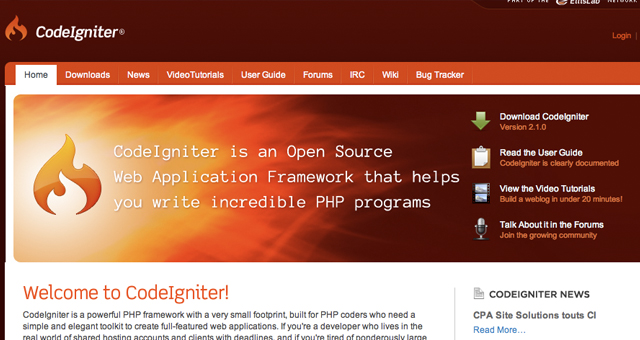A code framework is nothing more than a collection of pre-formatted classes and functions. There are frameworks created for practically every language out there – even including frontend web development like JavaScript and CSS. Developers would be wise to follow these trends when working on top of pre-built code.
There are reasons both for and against building on top of web frameworks. You need to spend time learning the code and adjust your website accordingly. But in the long run, you’ll save a lot of frustration as many common features have already been created for you! Let’s delve into these ideas a bit more and consider some of the most popular code frameworks today.
Improvements for Web Developers
Building products for the web can be one of the toughest development jobs. Rules are not set as standards in the same way Windows or Mac OSX programmers follow. Web developers need to work on a server architecture, generally writing in a backend programming language such as PHP or Ruby on Rails.
PHP is by far the most recognized development language for creating dynamic websites. You can build snappy applications working with databases in a short amount of time. And the new PHP5 specs have included a whole slew of additional functionality. The benefits of working on PHP frameworks mean you don’t need to start from the very beginning. It can be stressful to include a set of 3rd party libraries and build up your own system from scratch.

But there are plenty of alternative PHP libraries, which each focus on a different set of functions. Some may help you set up a simple blog, backend CMS, social network, or a handful of other common templates. And when you build upon open-source frameworks, you’ve actually got a whole community of developers behind you for support.
Model-View-Controller
The MVC hierarchy is crucial to understand when building with frameworks. If you have ever coded software or applications before, then developing them for the web seems very cryptic. MVC doesn’t appear to make much sense on a standard web page.
However, when you include a database connection, the functionality of a framework starts to take form. You have a model of functions crunching information to save/pull from the database. Then, you have a view of HTML/CSS styles on the front end, along with a controller generally represented by forms or inputs on the page.
Frameworks that follow the MVC coding style are generally a lot faster and easier to debug. You know exactly where to look for errors and bugs within the code. It also naturally separates the backend programming from your frontend design view. Because of this, much of the code you find online will also likely work on your own site.
There is a lot of room for recycling code to use on a similar project. This can save you loads of time as a developer and many hours of debugging!
Focus on Custom Functionality
When you start coding with a framework, it allows you to jump right into the detailed programming functions of your own project. Since all the groundwork is already set up, you don’t need to rewrite any of the basics. If you understand the basics, this can provide an immensely helpful system.
Most code sources are extremely reliable and thoroughly checked for bugs. This allows you to develop your own models, following a syntax similar to the framework itself, without any unnecessary worries. If you enjoy writing code from scratch, then this method is not likely to suit you. But the expendable nature of these frameworks means you can write code externally and port it over into the model.

Or, in many scenarios, you can actually build out a custom module! Not all frameworks support the plug-and-play mentality. Yet, it is a fairly common feature even among some frontend libraries. jQuery is the first which comes to mind featuring dozens of techniques for building your own plug-in. The web development framework Alloy is also modular and written for PHP 5.3+ environments.
Examples of PHP Frameworks
When just getting started, you want to stick with something reliable and easy to use. Newbies just getting into frameworks will enjoy Zend or CodeIgniter.

Both of these projects have been under development for a few years. The PHP community is very adapted to their code style, so you will not likely have a difficult time-solving problems. But if you start on any of these, I highly recommend skimming their documentation pages first! This will give you an idea of how these frameworks behave and if you can even utilize them.
Below are just a couple of ideas for enticing PHP frameworks to check out. I have been a fan of CakePHP in the past, although I mostly work with custom CMS these days.
- CakePHP – A very flexible option for newbies. There are no configuration edits or custom code required – just install the database, and Cake is good to go. The whole development team is very knowledgeable and willing to help with issues. There are also a handful of published books geared towards explaining common Cake trends. Check out the CakePHP training videos online if you want to learn more.
- Recess – A RESTful PHP framework for newbies and advanced programmers alike. Recess is lightning fast, super easy to learn, and perfect to install on a standard LAMP server environment.
- Adroit – A lightweight PHP5 framework to get you developing faster! The core is built around an MVC hierarchy and utilizes the Smarty template engine. It’s also a breeze to implement your own Ajax calls between the database and frontend view.
- Flourish – More of a general object-oriented library for coders. With this modular framework, you aren’t limited to the MVC paradigm, although it is an option. The code is very secure and provides tons of examples on their website.
- Yii Framework – A much more detailed framework for web developers. Yii allows you to rapidly prototype dynamic features such as user authentication, Ajax calls, caching, custom themes, and a whole lot more. Check out their full list of features on the website.
CSS Design Bundles
Code frameworks started out popular in the areas of backend development. Both software programmers and web developers have been utilizing these for years. But now, there are countless frontend developers releasing their own design frameworks.
CSS is by far the go-to style language for the web. You can mockup an entire web page with fonts, colors, content boxes, alignments, and tons of other effects – all without touching the HTML. It’s a brilliant coding system that has revolutionized the field of web development(especially with HTML5).
CSS libraries can save you even more hardships on the coding front. There are code frameworks that work on CSS grid systems, resetting browser defaults, dynamic webpage fonts, and a few other nifty concepts. Best of all, many of them are free to download and come with an open-source developer’s license.
Common Recommendations
In the list below, I’ve compiled some of my favorite CSS frameworks. This list will not be useful for everyone, as not all developers enjoy using these code libraries! I admit that, at times, it’s just easier to write all your own code from scratch.
But when you really need to shave time off a project, there’s no better solution than these libraries. Most can be downloaded and forked on GitHub from the original author. If we skipped over any good ones, let us know in the post comments!
Conclusion
I hope this article has paved the way for some interested developers to get started using frameworks. In the modern era, it has never been easier to get moving in building a website. There are many open-source databases of code you can start working on which are scalable in the long term.
Don’t try to push yourself into a single framework on the first day. I find it’s best to tread the waters a bit and try out a couple of different names. See if there are any that fit your needs best, as different developers need different tools to work with. Whether coding frontend or backend, you’ll slowly develop a sense of trust in these frameworks. Not only do they make your job easier, they provide a stable grounding for nearly any project you create in the future.
Related Topics
Top